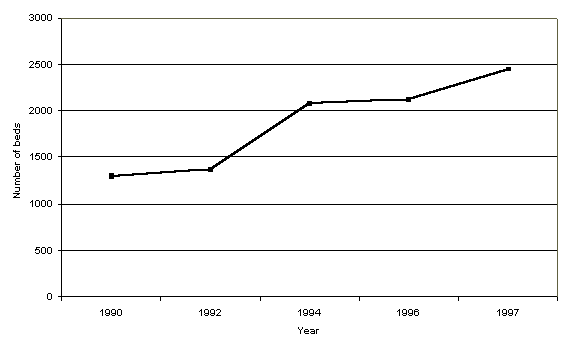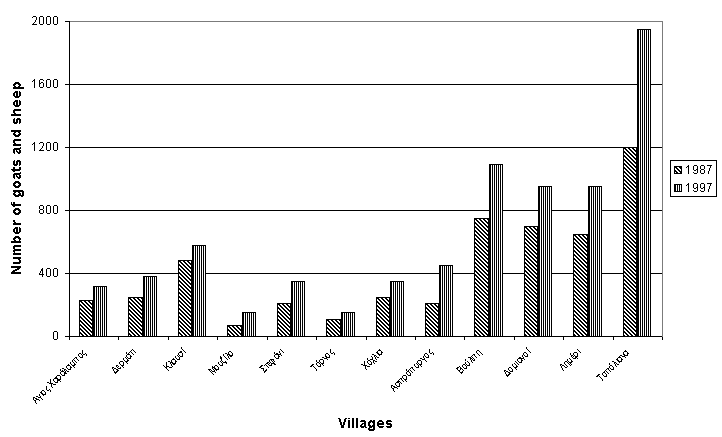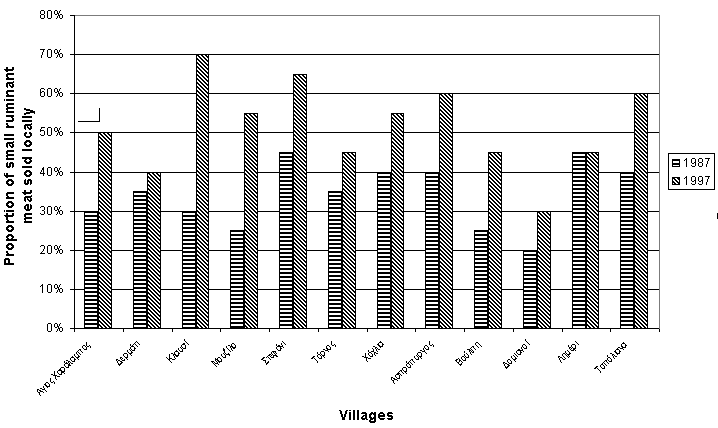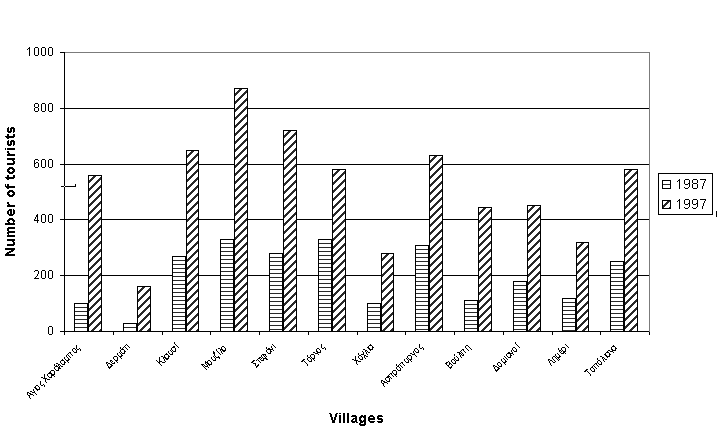 The James Hutton Institute
The James Hutton Institute
This page is no longer updated. The Macaulay Land Use Research Institute joined forces with SCRI on 1 April 2011 to create The James Hutton Institute.
2nd LSIRD Conference on Livestock
production in the European LFAs, Bray, Ireland. Dec '98
The process of change in the livestock systems
on small family farms in response to new development programs at a local
level: The example of mountainous region of Evritania - Greece
Dimitris Katsaros
Institute of Mountain and Rural Economics, Greece
Evritania, situated in Central Greece is an autonomous administrative
region and the only prefecture comprising 100% mountainous land. The area
suffers many of the problems associated with such areas in Greece and in
Mediterranean Europe in general. Such problems are:
1. Old age of the population, with few possibilities for regeneration from local births.
2. Rural exodus.
3. Abandonment of activities related to primary production.
The population density of Evritania is extremely low - officially there
are 11 inhabitants per square kilometre though in reality this figure is
much lower (about 9 inhabitants/km²). Pasture land, which is one of
the main productive resources, makes up 40% of the total land area of Evritania.
This land is, however, of poor quality. Animal husbandry is still the main
activity for many villages in Evritania, making it a priority that development
efforts be intensified towards "new" and more productive herds,
with the same traditional structures, but with up-to-date methods and ideas
that will lead to the production of pure, natural, high-value animal products.
Seasonal problems to supply herds with adequate nutrition occur. Pasture
plays an important role in feeding the herds for about 7-8 months, but
utilisation of this resource is poor. According to data from the Animal
Production Service the land is able to supply sufficient grazing to feed
the herds for just 4-5 months of the 7-8 months that the herds stay in
the area. The shortfall of resources has to be made up with bought in feeds,
with an adverse effect on farm net income.
The primary sector plays an important role in Evritania with three main
activities:
These three activities contribute an average of about 60% of total regional
income:
Crop farming is limited by the morphology of the land to just 5% of
the land area. Annual land use statistics show a decline in cropping, and
also in agricultural activity in general. The abandonment of farm land
continues to increase and there is little hope for the survival of farming
activities.
In the mountainous regions of Greece in general and in Evritania in
particular, livestock farmers form relationships with their land that grow
to become more than a simple productive procedure. This gives farming important
social significance such as:
In this context, the extensive management of small ruminants in particular plays an important role - requiring large areas of land and using local pasture resources, they manage the landscape and natural wealth.
It is generally agreed that the mountainous Mediterranean areas, including
most of Greece, have the necessary comparative advantages for the
survival of extensive small ruminant production. However, construction
of infrastructure has been limited, while laws forbidding mainly goat herds
to enter state-owned forest land are enforced in mountainous areas. This
restriction was established at a time when mountain animal production was
the main economic activity of the majority of the population. Though the
decisions to forbid livestock from state forest land had to be made at
the time, there was no concern for the producer's livelihoods. The measures
eliminated the herds and the farmers moved out of agriculture.
Today it is necessary to understand animal production at a local level
and to take a more realistic approach. The local potential must be identified
and encouraged to develop within the existing perspectives of small family
farm holdings in the mountains. Mountainous areas now undergo social and
economic changes on the basis of experimental or pilot programs that are
conceived and enforced by the planners of developmental programs both at
national and European level. In addition, the aim at a European and national
level, is wholly to develop a given area, activating the human labour and
the natural resources and capabilities. Thus, an analysis of more general
development planning is needed.
Whatever reservation one may have for the programs, it is the case that
the local market has to be won by mountain livestock producers, given that
there are problems to sell to distant city markets. The opportunity to
secure a quality premium has to be taken in some way, and while the livestock
product market is highly competitive, the sale through local markets offer
producers, in particular smaller producers, some advantages. Money paid
to feed livestock, especially during winter, can be found from higher selling
prices as quality-assured products. For this to become reality, consistent
and continued education of producers is needed.
The increased levels of tourism development, alternative tourism, and
especially rural tourism, provide an opportunity for the entrance of animal
production into new marketing channels. It should be noted here that rural
tourism (or agritourism) in Greece is conceived differently than in other
countries where it has flourished. Agritourism in Greece has nothing to
do with offering the experience of farm life to tourists, is in other countries
(France, UK, Canada etc.) It is simply the diversification of farm incomes
by offering accommodation in rented rooms. The purpose of this paper is,
however, to investigate how animal production can benefit from such an
activity which will change so dramatically the social, economic and cultural
behaviour of the traditional societies of mountainous areas.
Mountain livestock production in Evritania (as in all Greece) has to
enter this new and very promising market probably without external support,
using the initiative of farmers. This is primarily because there has been
little involvement by the state to understand and use the development possibilities
offered by the local animal production, education of farmers and their
successors, nor how to include traditional production systems in general
local development planning.
Tourism and Livestock.
The regional development agency, Evritania S.A. has been faced by these problems of social and economical abandonment of the area since it was created in 1980. Its role is to promote rural development by mobilising the endogenous human and natural resources.
Since then, the development agency started to enact development plans,
and little by little a local development policy was established.
Within the framework of EC programs, such as the Integrated Development
Programs, LEADER, and others, the development policy has been oriented
towards the secondary and tertiary sector, while the primary sector has
been largely left behind. The philosophy behind such programs encourages
internal development or self-development, as it is said. These programs
are based on the activation of human labour and offer radical solutions
for the regeneration of the local economy. They refer mainly to the support
of tertiary sector activities, and in particular rural tourism, but also
to the secondary sector with emphasis on the start-up and running of small
handicraft workshops and other businesses.
The passage from the traditional production systems to the new economic
activities used in traditional societies is now a milestone in the developmental
history of the mountains. For years neglected, the mountain economy is
now contributing to the general economic system of the country. However,
the implementation of development programs have caused certain problems
for the traditional societies and economies that are affected. The dynamics
of these effects are so important that they require consideration before
any radical changes offered by European and national schemes such as the
Integrated Mediterranean Programs (IMP) and L.E.A.D.E.R. should be implemented.
The local development policy adopted by the Agency relates mainly to
the promotion of tourism, tourist activities and alternative tourism (including
agritourism). Approximately 85% of the money invested aims to improve facilities
for tourism, such as in the provision of quality hotel and apartment accommodation.
70% of the investment under LEADER I was directed towards agritourism,
representing 50 rooms and 150 beds, while in Leader II , 60% of the investment
will create another 100 rooms with 250 beds.
This development policy helped at this stage to create an important
tourist demand. Also, a ski centre was developed, and municipal guesthouses
and large hotels appeared. But, mainly in the idea of agritourism in the
form of rented rooms that local young people were more interested to invest
(and not in the primary sector), as there were more advantageous rates
of subsidies. Incomes were increased, and families began to stay in the
area with their children.
Such alternative productive activities are preferred to the primary
sector, as the investment capital is easier and quicker returned and the
proportion of subsidy is more advantageous for the beneficiaries of the
development programs.
It is worthwhile to point out that this developmental policy created
a serious antagonism between the different sectors of the economy at a
local level and discouraged the investment of young population in the primary
sector. However, whatever reservations one has for the policy, it is true
that the expansion of tourism activity increased the demand in the local
market for milk and meat products, while the points of selling, i.e. the
meat and milk shops, increased considerably between 1990 and 1997. In Evritania,
between 1990 and 1997, the number of butchers shops grew from 25 to 34.
It is worth noting that, excluding Karpenissi, the prefecture's capital,
with 10,000 inhabitants and a total of 8 butcher shops, 26 others are scattered
throughout villages, where the average population is 150 inhabitants per
village. Such a number of inhabitants is much too low to justify their
existence simply to supply the needs of the local population.
The traditional rural hospitality, philoxenia , of Greece has
at its core the consumption of lamb and goat.
Figure 1 shows the evolution of tourism capacity, according to records
of overnight stays in hotels, municipal guesthouses and agritourism facilities
in Evritania during the last 7 years, and demonstrates the importance of
this activity in this region.

Figure 1. The evolution of tourism capabilities according to the hotels,
municipal guest houses and agritourism lodgings in Evritania from 1990
to 1997
Of the goats and sheep in Evritania, some are located on farms, others
are migrant and move around the area. This paper concentrates on the farm
situation, as it is considered that their existence and development contributes:
The data indicate the situation of the small family farmers (20 to 50
small ruminants) of some villages of the region that were surveyed. The
survey covered 12 villages (out of 81) and examined the situation of these
farm units over a ten year interval (1987 and 1997), using a specific questionnaire
send to the secretaries of the villages.

Figure 2. The changes in small ruminant populations on small farms (20
to 50 goats and sheep each) in 12 villages of Evritania from 1987 to 1997.
The proportion of meat sold locally by small producers over the same
period of time and in the same villages was also evaluated (Figure 3).

Figure 3. Local sales (%) in 1987 and 1997 of small ruminant products
(20 to 50 goats and sheep) in 12 villages of Evritania.
Finally, an assessment was made of the annual number of tourists and visitors for the same villages and period of time.

Figure 4. Annual number of tourists in 12 villages of Evritania from
1987 to 1997.
The results of this research demonstrate the strong link between the development of the small herds, the increase in local sales and the expansion of tourist visits to these villages.
In fact, the recent promotional efforts for rural tourism has helped
considerably, not only to maintain small producers but also to encourage
an increase in the number of animals, and the development of the local
retail outlets.
Ten years ago, most of the scientists, but also the local producers,
were certain that there was no hope of the small breeders to survive in
this area. With the above results, it can be confirmed that a new livestock
system has now developed - we can call it maybe "tourism extensive
livestock system"-that survives and develops alongside tourist development,
encouraged by schemes to promote integrated rural development. It is clear
that this is a fragile system in which production depends heavily on the
local demand for local products.
The sudden expansion of tourism in Evritania over the last eight years has continued to a point where this one-sided development, and the move to this new economic activity (that is aided by the improved road infrastructure) can be said to have made a positive contribution to mountain livestock farming, rather than follow the course of the Greek island areas. The islands have suffered almost complete abandonment of the primary sector because of the antagonism between the sectors of the economy.
Some suggestions
Actions aimed at the support of mountain livestock production should
be introduced as soon as possible, before the tourist accommodation activity
reaches the catastrophic levels found in the island areas. Mountain herding
should be helped to establish and maintain local marketing channels.
Whoever though, cries "help!" and "make it easy for us!"
should also "think sensitively", as major changes will influence
the rural economy and society in the direct future. The following suggestions
are not aimed to give the entire picture for the conclusive development
of the livestock sector. However, they do aim to awaken the "sensitivity"
of the responsible services to the need for immediate and low cost acts
towards supporting this activity. Therefore:
References
Anthopoulou Th., Gousios D. & Katsaros D. (1988). Social and economic
evolution of the Greek rural land. Problems and the future potentials:
The example of Evritania. In The disadvantageous Mediterranean zones
in EC -INRA, CEMAGREF-IAM, Vol. 2, pg. 245-275.
Giannakopoulos A.& Tassos G. (1993). Conclusive developmental plan
for stock breeding in Evritania prefecture". EVRITANIA S.A., Rural
Development Agency.
Katsaros D. & Anthopoulou Th. (1987). Allocation and new economic
activities in Evritania. In Bulletin de la Societe Languedocienne de
Geographie - Vol. 3-4, pp. 329-344.
Katsaros D. (1992). Self-developmental dynamics in mountainous rural land: Some local examples. In Agriculture in the '90's: Economical and social perspective - Panhellenic Convention on Rural Economy, pp. 249-260.
Katsaros D. (1997). The Mountain livestock systems. International conference of the ELPEN Network. Karpenissi, Greece.